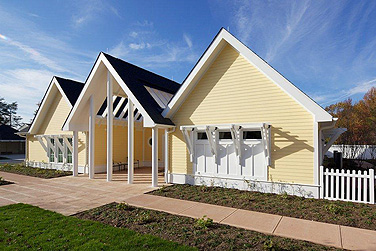News
Designing homes for ‘wounded warriors’

Patriot Home is one of two houses designed with features that address a variety of physical and emotional challenges a veteran might face. Photo: JIM KIRBY
-
 Print
Print -
 Comments
Comments
-

“The collaborative nature of the project allowed all members of the design team to contribute in their area of expertise, which I think shows in the strength of the final product.”
UB architect Danise Levine is part of a team that designed two houses for wounded veterans and their families as part of the Wounded Warrior Home Project.
Construction on the houses in Fort Belvoir, Va. was completed on Veterans Day.
The houses will fit the unique physical and emotional needs of the soldiers who will move in. The dwellings are universally designed to be accessible to people of diverse abilities and ages.
Sliding interior doors and wider hallways reduce obstructions and optimize maneuverability within the home. The sink, stove and table are equipped with automatic lifts that adjust their height to fit different users at the touch of a switch. Designers even took the appearance of the floor into account; contrasting floor patterns make it easy for residents with reduced vision to identify where one floor space ends and the next begins.
“The collaborative nature of the project allowed all members of the design team to contribute in their area of expertise, which I think shows in the strength of the final product,” says Levine, assistant director of UB’s Center for Inclusive Design and Environmental Access (IDeA Center).
Both new homes—the Freedom Home and the Patriot Home—address a variety of challenges that veterans might face. Exterior lights at entry points provide enhanced security and comfort for people suffering from post-traumatic stress disorder (PTSD), traumatic brain injuries and vision loss. Glass doors provide visual access to the outside. Automatic entry doors that are wider than usual provide unobstructed accessibility for someone with a limb amputation or to a person who uses a wheelchair.
Levine has been working with the Wounded Warrior Home Project since it began to take shape in February 2010. Her expertise in universal and accessible design guided the layout of the two homes that the builders are finishing this week.
“Danise’s feedback throughout the design stage has helped shape the homes that we see today,” says Adam Owens, project manager of the Wounded Warrior Home Project with Clark Realty Capital.
The Wounded Warrior Home Project aims to create a model for soldier housing that employs human-centered design, which focuses on the role housing plays in making a person’s life more dignified, healthy and rich.
UB’s IDeA Center will partner with the Wounded Warrior Home Project to study the usability of the homes after their completion. The goal is to improve future projects.
“We are excited to be a part of the UB IDeA Center’s research project to test the usability and effectiveness of the universally designed components of the homes to help improve the design and usability of future homes,” Owens says.
Levine, a registered architect, holds a master’s degree in architecture from UB. With more than 17 years of architectural practice experience, she has experience with architectural design for residential and commercial buildings, accessibility assessments and post-occupancy evaluations.
Her work has included designing close to 500 renovations to help people with unique needs in Western New York and beyond live comfortably in their homes.
Most of her clients are families whose children have disabilities. But others who have sought her help include veterans, individuals who have lost their mobility as a result of an accident and older adults hoping to remain in their homes as they age.
Levine plans to attend the Nov. 30 ribbon-cutting ceremony for the Wounded Warrior Home Project houses.

Reader Comments